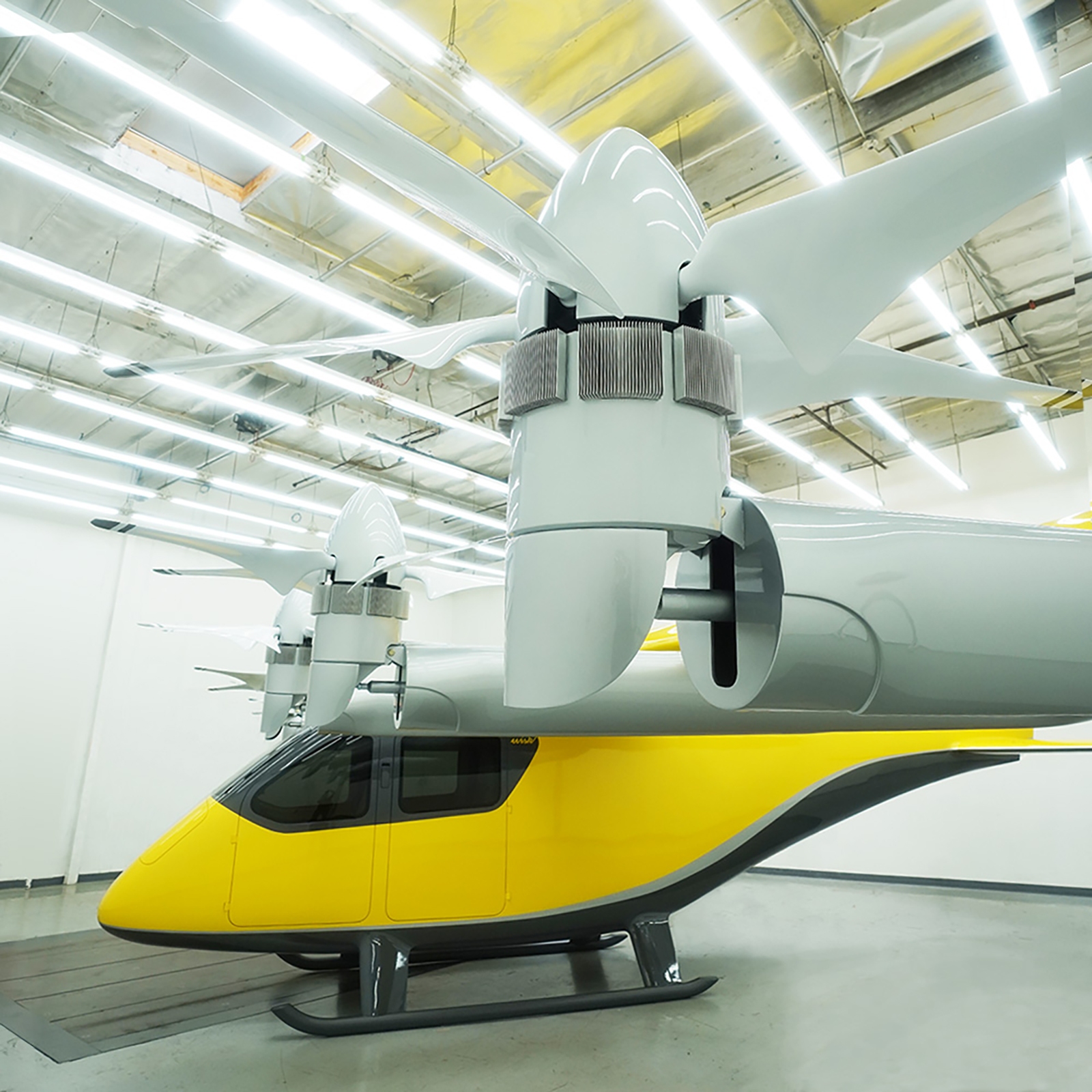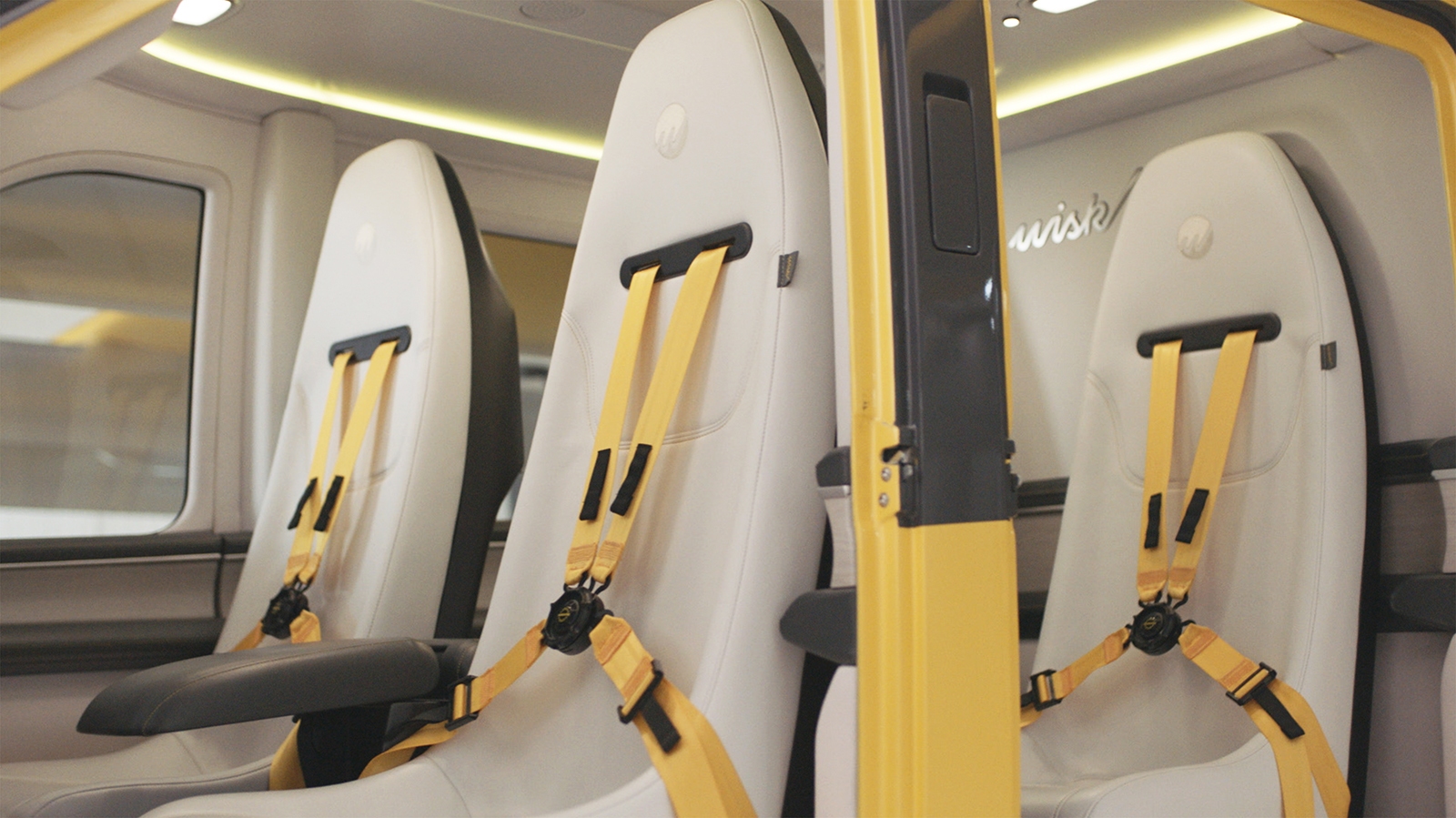Stay Up to Date
Submit your email address to receive the latest industry and Aerospace America news.
Novel design furthers company plan for air taxi with remote pilot monitoring
The production aircraft that air taxi developer Wisk Aero unveiled today in a press conference at its Silicon Valley headquarters is notable for its larger size, at four seats, and a very different type of tilting rotors on the front of the wing, in comparison with previous Wisk developmental versions.
The 15-meter wingspan of the remotely piloted Generation 6 aircraft has six booms, each mounted with two propellers. The front six propellers are tilt rotors, while the back six are only for lift and are stowed in an aerodynamic position for forward flight.
The developmental version immediately preceding Generation 6, the Cora demonstrator, had 12 fan-like propellers with virtually flat, rounded blades for generating vertical lift and one large propeller at the tail that provided forward thrust. But images of Generation 6 show the front six rotors are tiltable with a curved, more traditional propeller blade design. And gone is the rear propeller that provided forward thrust on previous designs.
The company revealed Gen 6, as it calls the aircraft internally, Monday in videos posted on its website and during a livestream hosted by president and CEO Gary Gysin and several other Wisk executives.
“With this aircraft, Wisk will redefine long-standing concepts of flight and usher in a safer, scalable, and more accessible era in aviation,” the company said in a release.
The company introduced a new propeller design to improve performance and reduce noise, both in the cabin and externally, especially during hover and transition, said Sebastien Vigneron, Wisk senior vice president of engineering and programs. I spoke to him via video several days before the press conference.
“Having a propeller on the back is actually heavy, and more work to get certified, because it’s a different engine than the lift propellers, so the new design has a very simple, very lightweight tail,” Vigneron said.
The six propellers on the front of the wing have five blades, while the four on the back have four, Vigneron said.
Previous designs had only two blades, he noted.
“Having more blades on each propeller reduces the amount of aerodynamic load you carry across each blade, and that helps reduce noise,” he said. “Also, its more efficient to have five blades for the forward propellers used during cruise, but the four blades on the back side of the wing are more easily locked into place during cruise.”
The result is more than double the amount of lift generated by the previous design installed on Cora, Vigneron explained.
The propellers on Gen 6 cannot auto rotate to make an emergency landing during loss of power, he said.
“With 12 propellers, we can actually lose two with no impact on passenger safety,” Vigneron said. “It cannot auto rotate because the size of the blades is not like that of a helicopter, but we have emergency landing procedures. If we lose two rotors, we just land. If there’s loss of communication, it just lands in what will be defined as emergency landing zones, like parking lots or rooftops, but we will of course favor vertiports. And it can glide if needed.”
Gen 6 is designed to have a range of up to 144 kilometers and fly at speeds up to 220 kilometers per hour up to 4,000 feet. Vigneron said Wisk plans for most passenger flights to be between 5 to 50 minutes.
Gen 6 won’t have a pilot aboard. The company believes that makes it the “first-ever candidate for certification” by FAA of a remotely piloted passenger aircraft, Wisk said in a press release. The company intends to have pilots or operators monitor the automated aircraft from the ground.
Wisk has not stated a target date for certification or service, saying only that the schedule will depend largely on FAA.
Gen 6 is “designed to be a service for everyone, with a price target of $3 per passenger, per mile,” the company said. That would mean a trip of 50 miles (80 kilometers) would cost about $150.
The company said it has made accessibility “a cornerstone of its design process” by creating four doors, two on each side, for “individuals across the mobility spectrum,” with user interfaces that can accommodate people living with hearing, vision and other impairments.
The company has performed 1,000 hours of test flights with previous test models, including the two-seat Cora, which the company plans to continue using for test flights and public demonstrations.
Some of Wisk’s potential competitors, like California-based Joby Aviation, plan to start passenger service in 2024 with pilots aboard. But Wisk, with some $450 million in funding from Boeing, plans to inaugurate its service with largely automated craft in five to 10 years, company officials have said.
Gen 6 includes “innovative technology such as improved detect and avoid capabilities, sensors, and more” to aid in flying without a pilot on board.
“We have already started sub-scale testing of Gen 6 and have completed multiple ground and flight tests, as well as component and systems tests,” Wisk spokesman Chris Brown told me via email.
Get the latest news about advanced air mobility delivered to your inbox every two weeks.
About paul brinkmann
Paul covers advanced air mobility, space launches and more for our website and the quarterly magazine. Paul joined us in 2022 and is based near Kennedy Space Center in Florida. He previously covered aerospace for United Press International and the Orlando Sentinel.
Related Posts
Stay Up to Date
Submit your email address to receive the latest industry and Aerospace America news.






